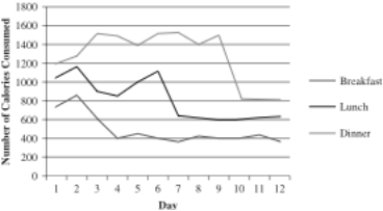Multiple Choice
Dr. Anderson is a nutritionist who helps clients lose weight prior to surgery. She is working with W. J., a male client who is planning on undergoing a heart transplant. He currently eats more than 3,500 calories a day and has been asked by his doctor to cut the number of calories to about 1,800 (400 for breakfast, 600 for lunch, and 800 for dinner) . She is curious as to whether a food journal will help W. J. reduce the number of calories he eats. A food journal is used to record everything a person eats to help patients be more aware of what they're eating. W. J.'s wife also recorded the food he consumed at each meal to have complete data before introducing the journal. Dr. Anderson decides to phase in the food journal gradually, initially only having W. J. record what he ate at breakfast during the first three days after baseline (days 4-6) . During days 7-9, the journal is used at lunch, too, and during days 10-12, it also is used during dinner. The data for Dr. Anderson's study are below.
What type of small-N design has Dr. Anderson used with W. J.?
A) Interrupted time-series design
B) Stable-baseline design
C) Multiple-baseline design
D) Reversal design
Correct Answer:

Verified
Correct Answer:
Verified
Q35: Layne is trying to watch less television.
Q36: Dr. LaGuardia is a cognitive neuroscientist who
Q37: List the three differences between small-N and
Q38: Dr. Fletcher is interested in whether joining
Q39: Explain why quasi-experiments and correlational studies can
Q41: How does a researcher who conducts a
Q42: Researchers may be interested in how a
Q43: Dr. Fletcher is interested in understanding whether
Q44: Which of the following is a difference
Q45: Dr. LaGuardia is a cognitive neuroscientist who